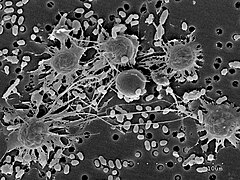Parvularia atlantis
Parvularia atlantis est une espèce d'amibes filopodiées qui a été isolée d'un lac à Atlanta et déposée dans l'American Type Culture Collection (ATCC) sous le nom de Nuclearia sp. ATCC 50694 de 1997 par T.K. Sawyer. Elle a été classée dans le genre Nuclearia du fait de sa ressemblance morphologique avec les espèces de ce genre, malgré sa petite taille (environ 4 µm de diamètre contre 9 à 60 µm pour les autres espèces). Par la suite, il a été déterminé qu'elle appartenait phylogénétiquement à une nouvelle lignée de Cristidiscoidea (ou Nucleariae)[1], éloignée des genres Nuclearia et Fonticula — les deux autres genres précédemment décrits. On a attribué à cette espèce aux caractéristiques phylogénétiques et morphologiques particulières, un genre distinct (Parvularia) parmi les Holomycota.
| Domaine | Eukaryota |
|---|---|
| Sous-domaine | Amorphea |
| Clade | Opisthokonta |
| Super-règne | Holomycota |
| Règne | Nucleariae |
| Classe | Fonticulea |
| Ordre | Fonticulida |
- Nuclearia sp. ATCC 50694
P. atlantis n'est pas le premier cas où une amibe filopodiée a été attribuée par erreur au genre Nuclearia. L'amibe Capsaspora owczarzaki a déjà été décrite comme Nuclearia[2], jusqu'à ce que les études phylogénétiques ne déplacent le genre Capsaspora des Holomycota aux Holozoaires[3].
P. atlantis se nourrit de bactéries en forme de bâtonnets et présente des cellules uni- ou binucléées. Au cours de son cycle de vie, P. atlantis peut former des cellules kystiques sphériques qui contiennent une couche extracellulaire intégrée.
Position phylogénétique
modifier| Opisthokonta 1300 Ma |
| ||||||||||||||||||||||||||||||||||||||||||||||||||||||||||||||||||||||||||||||||||||||||||||||||||||||||||||||||||
Notes et références
modifier- (en) David López-Escardó, Purificación López-García, David Moreira, Iñaki Ruiz-Trillo et Guifré Torruella, « Parvularia atlantis gen. et sp. nov., a Nucleariid Filose Amoeba (Holomycota, Opisthokonta) », Journal of Eukaryotic Microbiology, vol. 65, no 2, , p. 170–179 (ISSN 1550-7408, PMID 28741861, PMCID 5708529, DOI 10.1111/jeu.12450)
- A. Owczarzak, H. H. Stibbs et C. J. Bayne, « The destruction of Schistosoma mansoni mother sporocysts in vitro by amoebae isolated from Biomphalaria glabrata: an ultrastructural study », Journal of Invertebrate Pathology, vol. 35, no 1, , p. 26–33 (PMID 7365267, DOI 10.1016/0022-2011(80)90079-8)
- (en) Iňaki Ruiz-Trillo, Christopher E. Lane, John M. Archibald et Andrew J. Roger, « Insights into the Evolutionary Origin and Genome Architecture of the Unicellular Opisthokonts Capsaspora owczarzaki and Sphaeroforma arctica », Journal of Eukaryotic Microbiology, vol. 53, no 5, , p. 379–384 (ISSN 1550-7408, PMID 16968456, DOI 10.1111/j.1550-7408.2006.00118.x, S2CID 24862220)
- (en-US) Lab Multicellgenome et Torruella Guifré, « Transcriptome - Parvularia atlantis (Nuclearia sp. ATCC 50694) », Figshare, (DOI 10.6084/m9.figshare.3898485.v4, lire en ligne)
- (en) Alex de Mendoza, Arnau Sebé-Pedrós, Martin Sebastijan Šestak, Marija Matejčić, Guifré Torruella, Tomislav Domazet-Lošo et Iñaki Ruiz-Trillo, « Transcription factor evolution in eukaryotes and the assembly of the regulatory toolkit in multicellular lineages », Proceedings of the National Academy of Sciences, vol. 110, no 50, , E4858–E4866 (ISSN 0027-8424, PMID 24277850, PMCID 3864300, DOI 10.1073/pnas.1311818110 , Bibcode 2013PNAS..110E4858D)
- Hiroshi Suga, Guifré Torruella, Gertraud Burger, Matthew W. Brown et Iñaki Ruiz-Trillo, « Earliest Holozoan expansion of phosphotyrosine signaling », Molecular Biology and Evolution, vol. 31, no 3, , p. 517–528 (ISSN 1537-1719, PMID 24307687, PMCID 4342544, DOI 10.1093/molbev/mst241)
Bibliographie
modifier- (en) B. F. Lang, C. O'Kelly, T. Nerad, M. W. Gray et G. Burger, « The Closest Unicellular Relatives of Animals », Current Biology, Royaume-Uni, Cell Press et Elsevier, vol. 12, no 20, , p. 1773-1778 (ISSN 0960-9822 et 1879-0445, OCLC 45113007, PMID 12401173, DOI 10.1016/S0960-9822(02)01187-9, lire en ligne).
- (en) Bettina M. Scheel et Bernhard Hausdorf, « Dynamic evolution of mitochondrial ribosomal proteins in Holozoa », Molecular Phylogenetics and Evolution, Academic Press et Elsevier, vol. 76, , p. 67-74 (ISSN 1055-7903 et 1095-9513, PMID 24631858, DOI 10.1016/J.YMPEV.2014.03.005).
